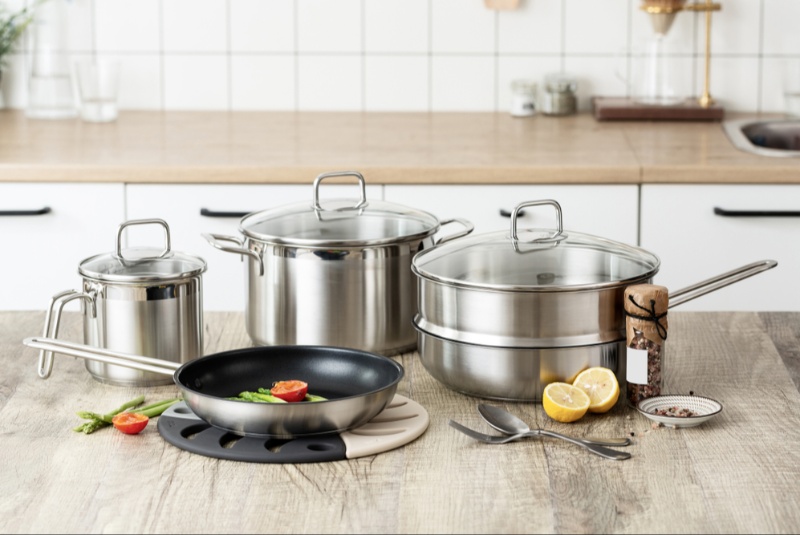Investing in high-quality pots and pans is essential for any kitchen. Whether you're a novice cook or a seasoned chef, having the right cookware can significantly impact the outcome of your culinary creations. However, with so many options available on the market, selecting pots and pans that will stand the test of time can be challenging. From materials and construction to features and price, there are several factors to consider when choosing long-lasting cookware for your kitchen. In this guide, we'll explore some tips to help you make informed decisions and invest in pots and pans that will serve you well for years to come.
Consider Your Cooking Style and Preferences
Before diving into the specifics of pot and pan selection, take some time to assess your cooking style, preferences, and kitchen habits. Consider the types of dishes you most frequently prepare, as well as your preferred cooking methods and techniques. For example, if you enjoy searing meats or sautéing vegetables, you'll want to prioritize pots and pans with excellent heat retention and conductivity. Similarly, if you often cook large batches of soups or stews, opting for pots with generous capacities will be beneficial. By understanding your cooking needs and preferences, you can narrow down the options and choose cookware that complements your culinary style.
Choose High-Quality Materials
The materials used in the construction of pots and pans play a significant role in their durability, performance, and longevity. While there are various materials available, some are known for their superior quality and longevity. Stainless steel is a popular choice for cookware due to its durability, resistance to corrosion, and non-reactive properties. It's ideal for searing, browning, and deglazing, making it versatile for a wide range of cooking tasks. Cast iron is another durable option known for its excellent heat retention and ability to develop a natural non-stick patina over time. Although cast iron requires seasoning and proper maintenance, it can last for generations with proper care. Other materials to consider include copper, aluminum, and ceramic, each offering unique advantages in terms of heat conduction and cooking performance.

Assess Construction and Design Features
In addition to materials, pay attention to the construction and design features of pots and pans when evaluating their durability and longevity. Look for cookware with sturdy handles that are securely attached to the body, preferably riveted for added strength and stability. Handles should remain cool to the touch during cooking to prevent burns and ensure safe handling. Additionally, inspect the weight and thickness of the cookware, as heavier pots and pans tend to be more durable and resistant to warping over time. Opt for pieces with tight-fitting lids and well-designed pouring spouts to minimize spills and splatters while cooking.
Evaluate Compatibility and Versatility
When selecting pots and pans, consider their compatibility with different cooktops and cooking methods to ensure maximum versatility and utility. While most cookware is designed for use on conventional stovetops like gas and electric, not all are compatible with induction cooktops. If you have an induction stove or plan to upgrade in the future, look for pots and pans with magnetic properties that can interact with induction heat. Additionally, consider whether the cookware is oven-safe and dishwasher-safe for added convenience and flexibility in cooking and cleaning. Choosing versatile pots and pans that can transition seamlessly between stovetop, oven, and dishwasher will enhance their longevity and usability in your kitchen.
Prioritize Non-Stick Coatings and Finishes
Non-stick coatings and finishes can significantly extend the lifespan of pots and pans by preventing food from sticking and facilitating easy cleanup. While traditional non-stick coatings like Teflon have raised concerns about health and safety, there are now safer alternatives available, such as ceramic and titanium-based coatings. These coatings offer excellent non-stick properties without the use of harmful chemicals like perfluorooctanoic acid (PFOA) and perfluorooctane sulfonate (PFOS), making them a healthier choice for cooking. Additionally, look for pots and pans with scratch-resistant finishes and reinforced coatings to withstand the rigors of daily use and maintain their non-stick properties over time.
Read Reviews and Compare Brands
Before making a final decision, take the time to research and compare different pot and pan brands to find reputable manufacturers known for producing high-quality, long-lasting cookware. Read customer reviews and testimonials to gain insights into the performance, durability, and reliability of various products. Look for brands with a track record of excellence in craftsmanship and customer satisfaction, as well as generous warranty coverage and responsive customer support. By investing in cookware from trusted brands with positive reputations, you can feel confident that you're getting the best value for your money and choosing pots and pans that will serve you well for years to come.
Choosing long-lasting pots and pans requires careful consideration of materials, construction, design features, and brand reputation. By assessing your cooking needs and preferences, prioritizing high-quality materials and construction, and evaluating compatibility and versatility, you can select cookware that will withstand the test of time and enhance your culinary adventures. Whether you prefer stainless steel, cast iron, or ceramic, investing in durable pots and pans from reputable brands will ensure that you have the tools you need to create delicious meals for years to come. With the right cookware in your kitchen arsenal, you can cook with confidence and enjoy the satisfaction of preparing meals that are as beautiful as they are delicious.
